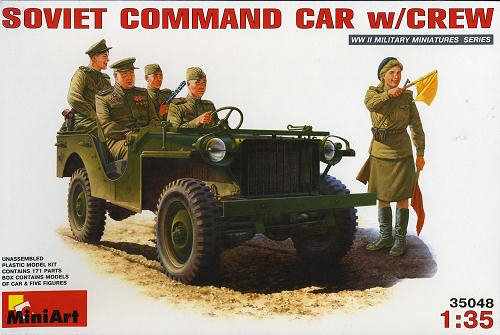
MiniArt 1/35 Soviet Command Car with Crew
| KIT #: | 35048 |
| PRICE: | Around $30.00 MSRP |
| DECALS: | Two options |
| REVIEWER: | Scott Van Aken |
| NOTES: | This is actually a Bantam BRC-40 |

| HISTORY |
The Origins of the Jeep and the Bantam
The Army's Ordnance Technical Committee specifications were demanding of the new reconnaissance car of 1940. The vehicle would be four-wheel drive, have a crew of three, on a wheelbase of no more than 75 (later 80) inches and tracks no more than 47 inches, a fold-down windshield, 660 lb payload and be powered by an engine capable of 85 ft·lbf (115 N·m) of torque. The most daunting demand however was an empty weight of no more than 1300 lb (590 kg).
Only three companies entered: American Bantam Car Company, Ford Motor Company and Willys-Overland Motors. Though Willys-Overland was the low bidder, Bantam received the bid, being the only company committing to deliver a pilot model in 49 days and production examples in 75. Under the leadership of designer Karl Probst, Bantam built their first prototype, dubbed the Blitz Buggy (and in retrospect "Old Number One"), and delivered it to the Army vehicle test center at Camp Holabird, Maryland on September 23, 1940. This presented Army officials with the first of what would eventually evolve into the World War II US Army Jeeps: the Willys MB and Ford GPW.
Since Bantam did not have the production capacity or fiscal stability to deliver on the scale needed by the War Department, the two losing bidders, Ford and Willys, were encouraged to complete their own pilot models for testing. The contract for the new reconnaissance car was to be determined by trials. As testing of the Bantam prototype took place from September 27 to October 16, Ford and Willys technical representatives present at Holabird were given ample opportunity to study the vehicle's performance. Moreover, in order to expedite production, the War Department forwarded the Bantam blueprints to Ford and Willys, claiming the government owned the design. Bantam did not dispute due to its precarious financial situation. By November 1940 Ford and Willys each submitted prototypes to compete with the Bantam in the Army's trials. The pilot models, the Willys Quad and the FordPygmy, turned out very similar to each other and were joined in testing by Bantam's entry, now evolved into a Mark II called the BRC 60. By then the US and its armed forces were already under such pressure, that all three cars were declared acceptable and orders for 1500 units per company were given, for field testing. At this time it was acknowledged the original weight limit (which Bantam had ignored) was unrealistic, and it was raised to 2160 lb (980 kg).
For these respective pre-production runs, each vehicle received revisions and a new name. Bantam's became the BRC 40, the subject of this kit, and the company ceased motor vehicle production after the last one was built in December 1941
This kit is called a 'Soviet command car', but is really a Bantam BRC 40. This is done to get around licensing fees, which must be pretty hefty to have to resort to this sort of tactic. Anyway, this is the 'full production' version of the Bantam and has all of the features of this little-produced vehicle. I'm surprised that any managed to find their way to the Soviets, but apparently some did. In terms of the molding, since this is the same vehicle previewed a few weeks back with US figures, there is little change.
The kit is very nicely molded in grey plastic . I was quite impressed to see that the kit has been engineered so that there are no mold release pin marks visible when the kit is complete. This is especially true of the leaf springs, a part on model vehicles that often suffers from these marks. This particular kit does, however have considerable flash on some of the parts, most notably the chassis. I also found that ejector pin marks were more prominent on this one and there were sink areas on the rear seat cushion that will need to be filled. Just goes to show that each time the sprues pop out of the mold, you are never sure how well they will turn out.
The kit is not a curbside, having a nicely detailed engine and suspension. There is detail enough to please all with most of the small parts, like hand holds, mirrors and lights, being separate pieces. The wheels have separate backing pieces that will help to make tire painting a bit easier. Clear inserts are provided for the windscreen and it can be moved down on the hood should one desire. There is even a hood prop to go on the inside of the hood. Included in the kit is a set of figures. This time it is figure set 35049 that has four soldiers riding in the jeep and a female directing traffic.
Instructions are well done and in color. There are 21 superbly illustrated construction steps. Apparently all is in olive green as there are no 'in work' painting instructions. The figures are shown in the painting section and a variety of paint makers are listed. No decals are given.
| CONCLUSIONS |
Well there you have it. Another boxing of the very nice and infrequently seen Bantam BRC 40 vehicle, this time with Russians on board. The vehicle should make into a superbly detailed model and the figures are just gravy.
| REFERENCES |
http://en.wikipedia.org January 2009
Thanks to www.dragonmodelsusa.com for the preview kit. Get yours today at your local shop or on-line retailer. If you would like your product reviewed fairly and fairly quickly, please contact the editor or see other details in the Note to Contributors.